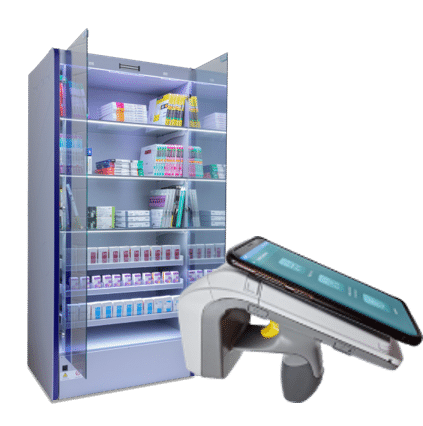What’s inside:
Switching to an automated and hybrid implant management system improves healthcare management.
This blog looks at:
- The increasing popularity of hybrid implant tracking systems in healthcare
- How does a full implant management solution work?
- Hybrid solutions: RFID smart cabinet plus virtual smart cabinet.
- The benefits of automated medical inventory management.
‘Real world’ inventory solutions
Our team regularly steps into different hospitals and healthcare facilities, and sees firsthand the diversity in inventory types, storage setups, and management systems. With providers being pressed for time and resources, it’s often wise to retain a real-world perspective, and find a way to initiate change with as little disruption as possible.
Hospitals today hold a wide range of stock on-site, some of it is kept in cabinets, and other items are stored on the shelves. When planning to add automation to their supply chain management, most providers need to use their existing set-up as their starting point, as they don’t have the luxury to redesign things from scratch.
What’s needed is an implant management pathway from outdated or manual systems to precision automation.
A bridge between tradition and innovation.
IDENTI’s approach to working in partnership with healthcare providers to optimize their inventory management, is to offer a workable solution based on the current setup. That’s why we developed a hybrid approach to managing implants, tissue, devices and other consumables.
Hybrid system for item-level implant tracking
Hybrid implant management represents a transformative approach to supply chain management in hospitals and ambulatory care facilities.
Unlike traditional methods, a hybrid hospital implant management system seamlessly blends digital technologies within the established way of working. In practical terms, it involves the integration of advanced tracking technologies, such as RFID (Radio-Frequency Identification) and cloud software, in order to achieve real-time, item-level inventory monitoring and stock control.

How does hybrid implant management work?
Each implant, or inventory item, is equipped with a digital identity, via an RFID tag, which is monitored via a data sensing system.
This hybrid hospital inventory management solution enables providers to monitor every stock item:
- INVENTORY TRACKING IN SMART CABINETS: Items stored in RFID smart cabinets, whether owned or consigned inventory, can be accurately monitored and tracked in real-time.
- INVENTORY TRACKING IN STOREROOMS Tagged stock items stored in hospital storerooms, whether owned or consigned inventory, can be monitored and tracked via a mobile app ‘shelf scanner’ and AI cloud software.
- SHARED SUPPLY CHAIN DATA: Third party access can be given to supply chain stakeholders such as distributors and vendors, so that common inventory vision is achieved, creating joint understanding of stock levels, and putting an end to disputes.

Hybrid solution for managing medical devices and implants
Increasingly, healthcare facilities are choosing a hybrid inventory management system, which gives full flexibility across inventory types and locations, to bring a wider range of stock items into a digitally managed solution.
Let’s take a look at what a hybrid inventory management solution looks like for monitoring stock stored in cabinets and in storerooms – while feeding data from both areas into a single management system.
- Smart cabinet: Smart cabinets are often reserved for high value items. UHF RFID sensors ensure perpetual item tracking, and the system reports on user activity, items in stock, items removed and items returned. In addition, reports ensure that all stock is used prior to expiry, reducing wastage costs. If expired or recalled items are found then the system alerts the team to their location so that they can be removed.
- Virtual Smart Cabinet: A mobile version of the smart cabinet, designed to manage storeroom stock in OR and procedural areas. It works by using RFID tags and a mobile application. The app can scan products stored on shelving and report back on the stock situation and expiry issues. It can also reconcile the on-hand inventory by reporting on the items removed from the shelves since the last scan. The system provides nurses with a quick and easy way to locate the specific items the need.
The combination of a smart cabinet and a virtual smart cabinet provides a comprehensive digital solution for supply chain management in ASCs and hospitals. This increased adaptability makes it a versatile choice for a diverse range of healthcare organizations.

Hybrid medical inventory tracking with unified implant management software
When a hybrid system is in place the best way to manage the data is via a single management system.
Hybrid inventory tracking solutions which combine a physical smart cabinets with a virtual storage app provide optimum value when they have a holistic digital approach. When data from the physical and virtual systems are combined within a single inventory management system this enhances efficiency by offering a unified management system that covers a broader spectrum of stock items in all locations.
The best systems can even combine the data from a wider range of inventory management tools, such as having a single platform for implant management as well as automated Kanban and PAR solutions, or even a point-of-use system for supply tracking.
This set up provides an overview of an even wider range of inventory, from high-value supplies to everyday consumables.

The benefits of automated inventory management
Hybrid solutions, which are able to monitor a larger variety of stock, in a broader range of locations, are growing in popularity as they increase the range of inventory data available.
Having an inventory management system in place with flexibility cross inventory types and locations benefits healthcare providers by ensuring smooth clinical, operational and financial management.
| Benefit | Details |
| Full inventory vision | Gain a full understanding of your owned stock, consignment items, or a combination of both. |
| Tight inventory control | Use system data to optimize stock usage. Automated recall and expiry management optimizes patient safety and reduces waste. |
| Reduction in medical inventory wastage through item-level stock control. | Prioritize the soonest-to-expire items for usage, preventing unnecessary and expensive waste. |
| Demand-led procurement | Achieve timely stock replenishments based on actual stock figures – ensuring products are always at hand when required. |
| Financial optimization of the supply chain | Use system data to inform decision-making, eg. inventory cost reductions, improved standardization, and improved contractual terms. |
| Improved regulatory compliance | Digital documentation helps to evidence good practice, compliance and boost patient safety. |
| Enhanced interoperability | Seamless integration supports the sharing of vital OR data across core systems. Hospital inventory data feeds into many vital clinical, operational and administrative workflows. |
| Timely, accurate inventory data | Metrics, reports and inventory analytics support smarter day-to-day management, as well as future forecasting and planning. |
How to choose the best hybrid implant management system for your healthcare facility
Not all systems offer the same level of performance, so how can providers select the best hybrid implant management system?
Here are 8 tips:
- Identify your current pain points. Is the existing system labor intensive? Does it provide accurate and timely data? Your current pain points should inform your selection of the new system.
- Take a holistic view. Inventory data feeds into clinical, operational and management systems, so identify what the recipients of the implant data need. How does this data affect compliance, procurement, medical billing, management decision making? Again, factor these goals into your selection process, so that the new system supports not just the management of medical inventory, but broader healthcare management.
- Use smart technology. The health-tech sector is moving at a fast pace. Identify emerging supply chain management technology and select systems that tap into this advanced technology.
- Get an interoperable system. Because inventory data feeds cross-organizational workflows it is vital that any new system or inventory management platform seamlessly integrates into your core systems, such as the ERP, EHR, MMIS/ORIS. Does the software synch with common electronic health record systems such as EPIC and Cerner? The days of duplicate entries into multiple systems belong in the past.
- Consider implementation. Find out how long the implementation process takes, whether there is a partnership approach to getting the system set up to suit the needs of the organization, whether it is a simple or complex process, the people involved, the time it will take. You want minimum disruption, it’s better to be aware of the full process when considering a new system.
- Think about training users. A system is only as good as its adoption rate. Staff need to get on board, feel confident and comfortable with the new system as soon as possible. What training is being offered? Are there various options so that staff on different shifts can access the training? How simple is the system to use and maintain?
- Ongoing support. How with the provider of the system support the implementation, training and post installation stages?
- Scalability. What happens if the organization grows? Can the system scale up easily?
If you understand your current needs and can carefully plan for a system change, then you are more likely to ask the right questions and better evaluate the implant tracking systems that are available on the market.
Is hybrid implant management better?
If you look holistically at the role of inventory management in healthcare delivery, the more data provided, and the better quality and timeliness of that data, have a big impact on decision-making.
The synergy between smart cabinets and virtual cabinets in hybrid implant management presents a clear paradigm shift. The blending of physical and digital components not only streamlines operations but also elevates patient safety and resource utilization.
The hybrid model of medical device and implant management ensures tighter control ‘s of a more diverse range of stock types and storage locations.
In the pursuit of reducing supply chain labor, enhancing precision management and reducing costs, the hybrid implant management system represents a smarter, more all-encompassing solution.
Ultimately, using a hybrid inventory tracking solution will enhance clinical, operational and financial management, while improving patient care.
Looking to upgrade your implant management? Why not go hybrid? Reach out for an informal chat.






